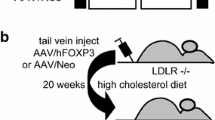Abstract
Induction of atherosclerosis in mice with one or more genetic alterations (e.g., conditional deletion of a gene of interest) has traditionally required crossbreeding with Apoe or Ldlr deficient mice to achieve sufficient hypercholesterolemia. However, this procedure is time consuming and generates a surplus of mice with genotypes that are irrelevant for experiments. Several alternative methods exist that obviate the need to work in mice with germline-encoded hypercholesterolemia. In this chapter, we detail an efficient and increasingly used method to induce hypercholesterolemia in mice through adeno-associated virus-mediated transfer of the proprotein convertase subtilisin/kexin type 9 (PCSK9) gene.
Access this chapter
Tax calculation will be finalised at checkout
Purchases are for personal use only
Similar content being viewed by others
References
Zhang SH, Reddick RL, Piedrahita JA et al (1992) Spontaneous hypercholesterolemia and arterial lesions in mice lacking apolipoprotein E. Science 258(5081):468–471. https://doi.org/10.1126/science.1411543
Plump AS, Smith JD, Hayek T et al (1992) Severe hypercholesterolemia and atherosclerosis in apolipoprotein E-deficient mice created by homologous recombination in ES cells. Cell 71(2):343–353. https://doi.org/10.1016/0092-8674(92)90362-G
Ishibashi S, Brown MS, Goldstein JL et al (1993) Hypercholesterolemia in low density lipoprotein receptor knockout mice and its reversal by adenovirus-mediated gene delivery. J Clin Invest 92(2):883–893. https://doi.org/10.1172/JCI116663
Daugherty A, Tall AR, Daemen MJAP et al (2017) Recommendation on design, execution, and reporting of animal atherosclerosis studies: a scientific statement from the American Heart Association. Circ Res 121(6):e53–e79. https://doi.org/10.1161/RES.0000000000000169
Alencar GF, Owsiany KM, Karnewar S et al (2020) Stem cell pluripotency genes Klf4 and Oct4 regulate complex SMC phenotypic changes critical in late-stage atherosclerotic lesion pathogenesis. Circulation 142(21):2045–2059. https://doi.org/10.1161/CIRCULATIONAHA.120.046672
Lusis AJ, Seldin MM, Allayee H et al (2016) The hybrid mouse diversity panel: a resource for systems genetics analyses of metabolic and cardiovascular traits. J Lipid Res 57(6):925–942. https://doi.org/10.1194/jlr.R066944
Bjørklund MM, Hollensen AK, Hagensen MK et al (2014) Induction of atherosclerosis in mice and hamsters without germline genetic engineering. Circ Res 114(11):1684–1689. https://doi.org/10.1161/CIRCRESAHA.114.302937
Roche-Molina M, Sanz-Rosa D, Cruz FM et al (2015) Induction of sustained hypercholesterolemia by single adeno-associated virus-mediated gene transfer of mutant hPCSK9. Arterioscler Thromb Vasc Biol 35(1):50–59. https://doi.org/10.1161/ATVBAHA.114.303617
Giunzioni I, Tavori H, Covarrubias R et al (2016) Local effects of human PCSK9 on the atherosclerotic lesion. J Pathol 238(1):52–62. https://doi.org/10.1002/path.4630
Getz GS, Reardon CA (2016) Do the Apoe−/− and Ldlr−/− mice yield the same insight on atherogenesis? Arterioscler Thromb Vasc Biol 36(9):1734–1741. https://doi.org/10.1161/ATVBAHA.116.306874
Bornfeldt KE, Kramer F, Batorsky A et al (2018) A novel type 2 diabetes mouse model of combined diabetic kidney disease and atherosclerosis. Am J Pathol 188(2):343–352. https://doi.org/10.1016/j.ajpath.2017.10.012
Jarrett KE, Lee C, De Giorgi M et al (2018) Somatic editing of Ldlr with adeno-associated viral-CRISPR is an efficient tool for atherosclerosis research. Arterioscler Thromb Vasc Biol 38(9):1997–2006. https://doi.org/10.1161/ATVBAHA.118.311221
Basu D, Hu Y, Huggins LA et al (2018) Novel reversible model of atherosclerosis and regression using oligonucleotide regulation of the LDL receptor. Circ Res 122(4):560–567. https://doi.org/10.1161/CIRCRESAHA.117.311361
Wu Z, Asokan A, Samulski RJ (2006) Adeno-associated virus serotypes: vector toolkit for human gene therapy. Mol Ther 14(3):316–327. https://doi.org/10.1016/j.ymthe.2006.05.009
Collins DE, Reuter JD, Rush HG et al (2017) Viral vector biosafety in laboratory animal research. Comp Med 67(3):215–221. https://doi.org/10.1002/cphc.201700089
Allain CC, Poon LS, Chan CSG et al (1974) Enzymatic determination of total serum cholesterol. Clin Chem 20(4):470–475. https://doi.org/10.1093/CLINCHEM/20.4.470
Lu H, Howatt DA, Balakrishnan A et al (2016) Hypercholesterolemia induced by a PCSK9 gain-of-function mutation augments angiotensin II-induced abdominal aortic aneurysms in C57BL/6 mice-brief report. Arterioscler Thromb Vasc Biol 36(9):1753–1757. https://doi.org/10.1161/ATVBAHA.116.307613
Acknowledgments
This work was supported by grants from The Lundbeck Foundation (R230-2016-3644 to MMB), the Novo Nordisk Foundation (NNF17OC00306889 to JFB), and the Ministerio de Ciencia, Innovación y Universidades (MCIU) (BFU2016-75144-R to JAB). The CNIC is supported by the Instituto de Salud Carlos III (ISCIII), the Ministerio de Ciencia e Innovación (MCIN) and the Pro CNIC Foundation, and is a Severo Ochoa Center of Excellence (SEV-2015-0505).
Author information
Authors and Affiliations
Corresponding author
Editor information
Editors and Affiliations
Rights and permissions
Copyright information
© 2022 The Author(s), under exclusive license to Springer Science+Business Media, LLC, part of Springer Nature
About this protocol
Cite this protocol
Bjørklund, M.M., Bernal, J.A., Bentzon, J.F. (2022). Atherosclerosis Induced by Adeno-Associated Virus Encoding Gain-of-Function PCSK9 . In: Ramji, D. (eds) Atherosclerosis. Methods in Molecular Biology, vol 2419. Humana, New York, NY. https://doi.org/10.1007/978-1-0716-1924-7_27
Download citation
DOI: https://doi.org/10.1007/978-1-0716-1924-7_27
Published:
Publisher Name: Humana, New York, NY
Print ISBN: 978-1-0716-1923-0
Online ISBN: 978-1-0716-1924-7
eBook Packages: Springer Protocols




